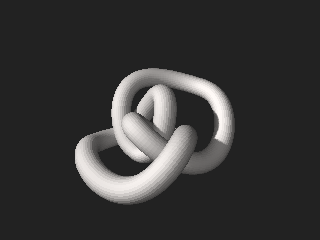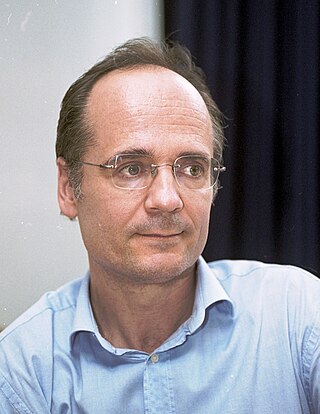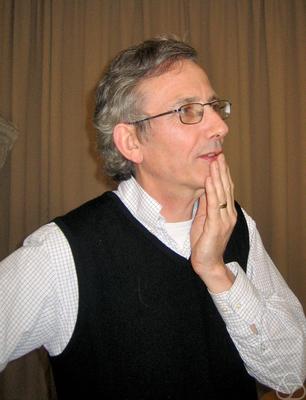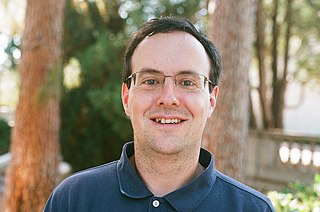Related Research Articles

In mathematics, topology is concerned with the properties of a geometric object that are preserved under continuous deformations, such as stretching, twisting, crumpling, and bending; that is, without closing holes, opening holes, tearing, gluing, or passing through itself.
In mathematics, a diffeology on a set generalizes the concept of smooth charts in a differentiable manifold, declaring what the "smooth parametrizations" in the set are.

In mathematics, and particularly topology, a fiber bundle is a space that is locally a product space, but globally may have a different topological structure. Specifically, the similarity between a space and a product space is defined using a continuous surjective map, that in small regions of behaves just like a projection from corresponding regions of to The map called the projection or submersion of the bundle, is regarded as part of the structure of the bundle. The space is known as the total space of the fiber bundle, as the base space, and the fiber.

Dušan D. Repovš is a Slovenian mathematician from Ljubljana, Slovenia.

Charles Ehresmann was a German-born French mathematician who worked in differential topology and category theory.

Harold Calvin Marston Morse was an American mathematician best known for his work on the calculus of variations in the large, a subject where he introduced the technique of differential topology now known as Morse theory. The Morse–Palais lemma, one of the key results in Morse theory, is named after him, as is the Thue–Morse sequence, an infinite binary sequence with many applications.

Sir Simon Kirwan Donaldson is an English mathematician known for his work on the topology of smooth (differentiable) four-dimensional manifolds, Donaldson–Thomas theory, and his contributions to Kähler geometry. He is currently a permanent member of the Simons Center for Geometry and Physics at Stony Brook University in New York, and a Professor in Pure Mathematics at Imperial College London.

Ralph Hartzler Fox was an American mathematician. As a professor at Princeton University, he taught and advised many of the contributors to the Golden Age of differential topology, and he played an important role in the modernization and main-streaming of knot theory.

In mathematical knot theory, the Hopf link is the simplest nontrivial link with more than one component. It consists of two circles linked together exactly once, and is named after Heinz Hopf.
In mathematics, a piecewise linear (PL) manifold is a topological manifold together with a piecewise linear structure on it. Such a structure can be defined by means of an atlas, such that one can pass from chart to chart in it by piecewise linear functions. This is slightly stronger than the topological notion of a triangulation.

Robion Cromwell Kirby is a Professor of Mathematics at the University of California, Berkeley who specializes in low-dimensional topology. Together with Laurent C. Siebenmann he developed the Kirby–Siebenmann invariant for classifying the piecewise linear structures on a topological manifold. He also proved the fundamental result on the Kirby calculus, a method for describing 3-manifolds and smooth 4-manifolds by surgery on framed links. Along with his significant mathematical contributions, he has over 50 doctoral students and his problem list.
In differential geometry, in the category of differentiable manifolds, a fibered manifold is a surjective submersion

Jeff Cheeger is a mathematician. Cheeger is professor at the Courant Institute of Mathematical Sciences at New York University in New York City. His main interests are differential geometry and its connections with topology and analysis.

William Bernard Raymond Lickorish is a mathematician. He is emeritus professor of geometric topology in the Department of Pure Mathematics and Mathematical Statistics, University of Cambridge, and also an emeritus fellow of Pembroke College, Cambridge. His research interests include topology and knot theory. He was one of the discoverers of the HOMFLY polynomial invariant of links, and proved the Lickorish-Wallace theorem which states that all closed orientable 3-manifolds can be obtained by Dehn surgery on a link.

John Robert Stallings Jr. was a mathematician known for his seminal contributions to geometric group theory and 3-manifold topology. Stallings was a Professor Emeritus in the Department of Mathematics at the University of California at Berkeley where he had been a faculty member since 1967. He published over 50 papers, predominantly in the areas of geometric group theory and the topology of 3-manifolds. Stallings' most important contributions include a proof, in a 1960 paper, of the Poincaré Conjecture in dimensions greater than six and a proof, in a 1971 paper, of the Stallings theorem about ends of groups.

Matthias Kreck is a German mathematician who works in the areas of Algebraic Topology and Differential topology. From 1994 to 2002 he was director of the Oberwolfach Research Institute for Mathematics and from October 2006 to September 2011 he was the director of the Hausdorff Center for Mathematics at the University of Bonn, where he is currently a professor.
Alexander Chigogidze was a Georgian-born general topologist. Chigogidze is best known for his book Inverse Spectra, in which he passed on to the next generation of topologists the results of the Fedorchuk -Schepin Topology seminars held at the Moscow State University during the 1980s. The book also contains important contributions Chigogidze made in the area of General Topology and Geometric Topology. In the area of General Topology, Chigogidze developed extension theory for noncompact nonmetrizable spaces. In the area of Geometric Topology, Chigogidze introduced grading to shape theory by developing a theory n-Shape where n is an arbitrary integer. This was a major addendum to the existing n-Homotopy theory.
Paul Stephen Aspinwall is a British theoretical physicist and mathematician, who works on string theory and also algebraic geometry.
Godfrey Peter Scott, known as Peter Scott, was a British mathematician, known for the Scott core theorem.

Denis Auroux is a French mathematician working in geometry and topology.
References
- ↑ Coram, D.; Duvall, P. (1977). "Approximate fibrations". Rocky Mountain Journal of Mathematics. 7 (2): 275–288. doi: 10.1216/RMJ-1977-7-2-275 .
- ↑ Hughes, Taylor & Williams 1995 , § 1.
- ↑ Hughes, Taylor & Williams 1995 , Introduction
- Hughes, C.B.; Taylor, L.R.; Williams, E.B. (July 1995). "Rigidity of fibrations over nonpositively curved manifolds". Topology. 34 (3): 565–574. doi: 10.1016/0040-9383(94)00035-J .